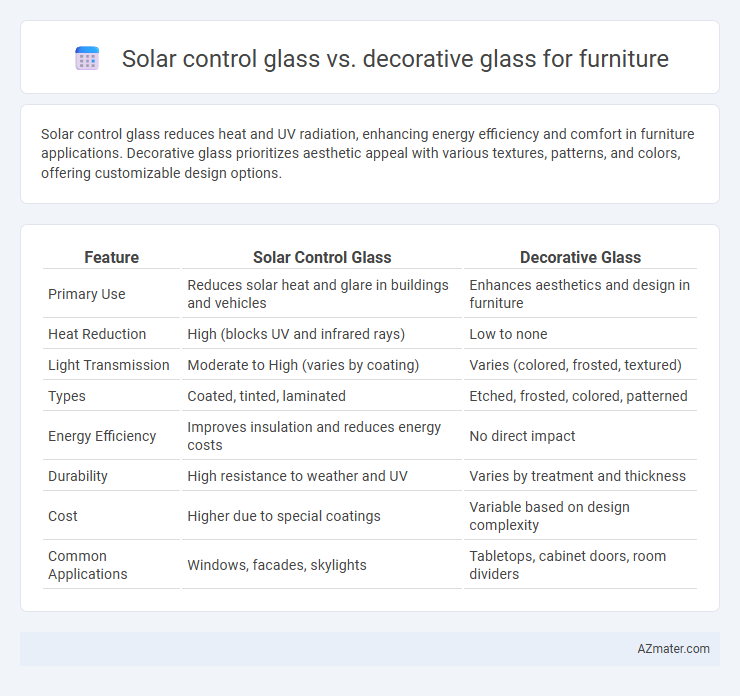Solar control glass reduces heat and UV radiation, enhancing energy efficiency and comfort in furniture applications. Decorative glass prioritizes aesthetic appeal with various textures, patterns, and colors, offering customizable design options.
Table of Comparison
| Feature | Solar Control Glass | Decorative Glass |
|---|---|---|
| Primary Use | Reduces solar heat and glare in buildings and vehicles | Enhances aesthetics and design in furniture |
| Heat Reduction | High (blocks UV and infrared rays) | Low to none |
| Light Transmission | Moderate to High (varies by coating) | Varies (colored, frosted, textured) |
| Types | Coated, tinted, laminated | Etched, frosted, colored, patterned |
| Energy Efficiency | Improves insulation and reduces energy costs | No direct impact |
| Durability | High resistance to weather and UV | Varies by treatment and thickness |
| Cost | Higher due to special coatings | Variable based on design complexity |
| Common Applications | Windows, facades, skylights | Tabletops, cabinet doors, room dividers |
Introduction to Glass Types in Furniture
Solar control glass in furniture enhances energy efficiency by reducing heat transfer and UV radiation, making it ideal for climate-sensitive interiors. Decorative glass, characterized by textured, colored, or patterned surfaces, primarily serves aesthetic purposes, adding style and personalization to furniture pieces. Understanding these glass types helps in selecting the right balance of functionality and design for various furniture applications.
What is Solar Control Glass?
Solar control glass is engineered to reduce heat gain by reflecting and absorbing solar radiation, enhancing energy efficiency in furniture by maintaining cooler surfaces and protecting interiors from UV damage. Unlike decorative glass, which primarily emphasizes aesthetic appeal through patterns, colors, or textures, solar control glass prioritizes functionality by optimizing thermal performance and glare reduction. This makes solar control glass ideal for furniture applications requiring both comfort and durability in environments exposed to sunlight.
Understanding Decorative Glass
Decorative glass for furniture enhances aesthetic appeal by incorporating unique textures, patterns, and colors, offering customizable design options that complement interior styles. Unlike solar control glass, which primarily reduces heat and UV transmission through specialized coatings, decorative glass prioritizes visual impact and personalization. Understanding decorative glass involves recognizing its role in adding artistic value and distinctive character to furniture pieces while maintaining functional transparency and durability.
Key Features of Solar Control Glass
Solar control glass for furniture features advanced coatings that reduce heat transmission, enhance UV protection, and improve energy efficiency by minimizing glare and maintaining indoor temperature. This glass type offers durability and clarity while preventing fading of furniture materials caused by sun exposure. Unlike decorative glass, which prioritizes aesthetic patterns and textures, solar control glass emphasizes functional benefits such as thermal insulation and long-term protection against solar radiation.
Unique Attributes of Decorative Glass
Decorative glass for furniture offers unique attributes such as intricate patterns, textures, and embedded designs that enhance aesthetic appeal and create personalized interior styles. Unlike solar control glass, which primarily reduces heat and glare by filtering UV and infrared rays, decorative glass emphasizes artistic expression while maintaining transparency and durability. Its versatility in customization allows designers to achieve both functional and visually striking furniture pieces tailored to specific decor themes.
Thermal Performance Comparison
Solar control glass significantly reduces heat transfer by reflecting and absorbing solar radiation, maintaining cooler indoor temperatures and enhancing energy efficiency in furniture applications. Decorative glass typically lacks advanced thermal properties, allowing higher heat penetration, which may cause discomfort and potential damage to sensitive materials in furniture. Consequently, solar control glass offers superior thermal performance, making it the preferred choice for furniture exposed to direct sunlight.
Aesthetic Impact in Furniture Design
Solar control glass enhances furniture design by integrating tinted or reflective coatings that reduce glare and heat while maintaining a sleek, modern aesthetic. Decorative glass offers diverse patterns, textures, and colors that add unique visual interest and personalization to furniture pieces. Both types significantly influence the overall ambiance and style, with solar control glass emphasizing functional elegance and decorative glass prioritizing artistic expression.
Cost and Maintenance Differences
Solar control glass offers energy efficiency benefits by reducing heat transfer, which can lower cooling costs over time but typically comes at a higher initial price compared to decorative glass. Maintenance for solar control glass involves regular cleaning to preserve its coating effectiveness and prevent degradation, whereas decorative glass requires less specialized care, focusing mainly on surface cleaning to maintain aesthetic appeal. Choosing between the two depends on balancing upfront investment against long-term energy savings and maintenance needs.
Application Suitability: Solar Control vs Decorative Glass
Solar control glass is ideal for furniture in environments with high sunlight exposure, as it effectively reduces heat and UV radiation, enhancing comfort and protecting interior materials from fading. Decorative glass is best suited for aesthetic applications in furniture, offering a wide range of textures, colors, and patterns that complement interior design without necessarily providing thermal or UV protection. Choosing between solar control and decorative glass depends on balancing functional performance with visual appeal in specific furniture settings.
Choosing the Right Glass for Your Furniture
Solar control glass enhances furniture by reducing heat and UV exposure, protecting upholstery and maintaining a cooler environment, ideal for sun-exposed spaces. Decorative glass prioritizes aesthetics with varied textures, patterns, and colors, offering a unique style element without compromising functionality. Selecting the right glass depends on balancing thermal performance needs with design preferences to create furniture that is both visually appealing and energy-efficient.

Infographic: Solar control glass vs Decorative glass for Furniture
 azmater.com
azmater.com